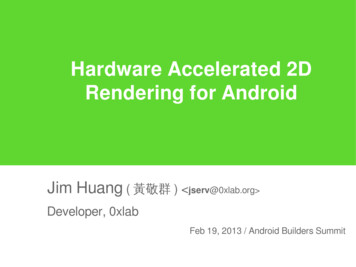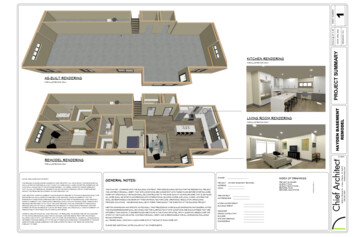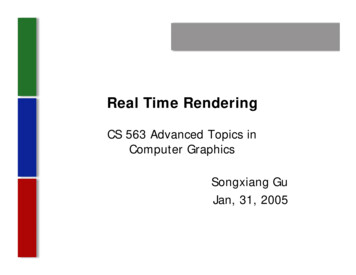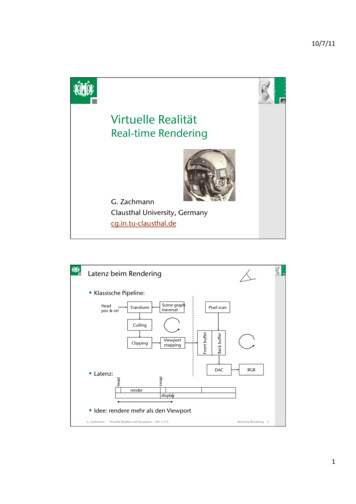
Transcription
Hardware Accelerated 2DRendering for AndroidJim Huang ( 黃敬群 ) jserv@0xlab.org Developer, 0xlabFeb 19, 2013 / Android Builders Summit
Rights to copy Copyright 2013 0xlabhttp://0xlab.org/contact@0xlab.orgAttribution – ShareAlike 3.0Corrections, suggestions, contributions and translationsYou are freeare welcome!to copy, distribute, display, and perform the workLatest update: Feb 19, 2013to make derivative worksto make commercial use of the workUnder the following conditionsAttribution. You must give the original author credit.Share Alike. If you alter, transform, or build upon this work, you may distribute theresulting work only under a license identical to this one.For any reuse or distribution, you must make clear to others the license terms of this work.Any of these conditions can be waived if you get permission from the copyright holder.Your fair use and other rights are in no way affected by the above.License text: lcode
Agenda(1) Concepts(2) Performance Problems(3) Hardware AcceleratingCase study: skia, webkit
ConceptsGraphic Toolkit, Rendering, GPU operations
Revise what you saw on Android
Exporting Graphics can be exported from any of the levels of the graphics stack– Application, Graphic Toolkit, Graphic Rendering, Bitmapped Device
Exporting Graphics - Application Normal way Linux/Android/Iphone runs apps.– The application itself is exported and run locally.
Exporting Graphics - Toolkit Technically very complex. Android has 15 different toolkit API variants. Every application can extend the toolkit with custom widgets(subclasses of android.view.View).Exporting Graphics - Rendering Exports graphics at the rendering level. In Android there are a number of rendering interfaces that can be used:– skia graphics– OpenGL ES 1.1 or OpenGL ES 2.0– Android.view.View
2D Graphics The display presents us the contents of something called theframebuffer. The framebuffer is an area in (V)RAM For each pixel on screen there‘s a corresponding memory cell in theframebuffer Pixels are addressed with 2D coordinates.
2D Graphics To change what is displayed change the colors of pixels in (V)RAM.– Pixel colors are encoded as RGB or RGBA To draw shapes need to figure out which framebuffer pixels we haveto set.– Images (bitmaps) are not special either– Pixels of the bitmap get stored in a memory area, just like we storeframebuffer pixels. To draw a bitmap to the framebuffer copy the pixels. (Blitting) We can perform the same operations on bitmaps as we perform on theframebuffer, e.g. draw shapes or other bitmaps.
Blitting: copy (parts of) one bitmap to anotherAlpha Compositing: blitting alpha blending Alpha value of a pixelgoverns transparency Instead of overwritting adestination pixel we mix itscolor with the source pixel.Source:Source: AndroidAndroid GameGame DevelopmentDevelopment 101,101, BadlogicGamesBadlogicGames
Android Graphics Stack
Rendering Level: skia The rendering level is the graphics layer thatactually “colors” the pixels in the bitmap. skia is a compact open source graphics librarywritten in C . Currently used in Google Chrome, Chrome OS,and Android.SkiaSkia isis GreekGreek forfor “shadow”“shadow”
Rendering Level: skia skia is a complete 2D graphic library for drawingText, Geometries, and Images. Features include:– 3x3 matrices w/ perspective– Antialiasing, transparency, filters– Shaders, xfermodes, maskfilters, patheffects
Rendering Level: skia Each skia call has two components:– the primitive being drawing(SkRect, SkPath, etc.)– color/style attributes (SkPaint) Usage wRect(rect, paint);canvas.drawText(“abc”, 3, x, y, paint);canvas.restore();
WebKit in AndroideventWebCoreSkia bridgeWebKitv8Refresh the surface(expose View.skiaskiaJNIJNIskia-gpuskia-gpuSurfaceSurface
CPU vs. GPU Limited at RenderingTasks over %40%30%30%20%20%10%10%0%1998 1999 2000 2001 2002 2003 2004 2005 2006 2007 2008 2009 2010 2011 2012Pipelined 3D Interactive Rendering0%GPUCPU1998 1999 2000 2001 2002 2003 2004 2005 2006 2007 2008 2009 2010 2011 2012Path RenderingGoal of NV path rendering is to make path rendering a GPU-limited taskRender all interactive pixels, whether 3D or 2D or web content with the GPUSource:Source: GPU-AcceleratedGPU-Accelerated 2D2D andand WebWeb Rendering,Rendering, MarkMark Kilgard,Kilgard, NVIDIANVIDIA
Rendering Paths[ skia gpu; Chrome browser ]JavaScript(Canvas)OpenGL ESDraw CallDraw CallComputingContextDraw CallDraw CallComputingContextDraw CallDraw CallComputingContextDraw CallDraw CallDraw CallDraw PUFlush
Rendering Paths[ ideal case ]JavaScript(Canvas)GL requestOptimizerOpenGL ESCPUGPUDraw CallDraw CallDraw CallDraw CallDraw CallDrawCallComputingContextFlush
skia gpu Problems– calls glDrawSomethings too many times– changes gl states too many times– switches FBO too many times– vector graphics APIs and shadows are really slow Increases dramatically CPU overheadDraw Call At OnceIdeal GLskiaBitmap SpriteGoodGoodConvex PathGoodPoorConcave PathGoodPoorBitmap Sprite PathGoodPoorPath Different ShadowGoodPoorText Different Draw CallGoodPoor
The performance problem is stillrendering.Let's look into deeper.
Hardware AcceleratingHow Android utilizes GPU functionalities
Myths and Facts Myth: Android 1.x is slow because of nohardware accelerations– NOT TRUE! window compositing utilizeshardware accelerations.– But it is quite constrained There are 4 Window: Status Bar, Wallpaper,Launcher, and Menu in the right screenshot.– Hardware composites animations of Activitytransition, the fading in/out of Menu. However, the content of Window (Canvas) isbeing accelerated by hardware since Android 3.x
View & TextureView View– represents the basic building block for UI– occupies a rectangular area on the screen and isresponsible for drawing and event handling. SurfaceView– provides a dedicated drawing surface embedded inside ofa view hierarchy. TextureView– Since Android 4.0– Only activated when hardware acceleration is enabled !– has the same property of SurfaceView, but you can createGL surface and perform GL rendering above them.
from EGL to SurfaceFlingerhardwarehardwareOpenGL ESOpenGL ESandroidandroid softwaresoftwareOpenGL ESOpenGL ES rendererrenderer
Case study: skiaPaint, Canvas, Backend
skia, againDrawing basic primitives include rectangles, rounded rectangles, ovals, circles,arcs, paths, lines, text, bitmaps and sprites. Paths allow for the creation of moreadvanced shapes.Canvas encapsulates all of the state aboutdrawing into a device (bitmap).While Canvas holds the state of the drawing device, the state (style) of theobject being drawn is held by Paint, which is provided as a parameter toeach of the draw() methods. Paint holds attributes such as color, typeface,textSize, strokeWidth, shader (e.g. gradients, patterns), etc.
skia rendering pipelineSource:Source: html
Skia backends Render in software– create a native window and then– wrap a pointer to its buffer as an SkBitmap– Initialize an SkCanvas with the bitmap Render in hardware acceleration– create a GLES2 window or framebuffer and– create the appropriate GrContext, SkGpuDevice, andSkGpuCanvas
How Views are Drawn [Android 2.x]
Hardware-accelerated 2D Rendering Since Android 3.x, more complex than before! Major idea: transform the implementation of 2D GraphicsAPIs into OpenGL ES requests Texture, Shader, GLContext, pipeline, Major parts for hardware-accelerated 2D Rendering– Primitive Drawing: Shape, Text,Image– Layer/Surface Compositing
Control hardware accelerations Application level application android:hardwareAccelerated "true" – Default value False in Android 3.x, True in Android 4.x Activity WindowWindowManager.LayoutParams.FLAG HARDWARE ACCELERATED View– setLayerType(View.LAYER TYPE SOFTWARE,null)View.setLayerType(int type,Paint p)LayersLayers Off-screenOff-screen BuffersBuffers oror CachesCaches
View Layers since Android 3.xSource:AcceleratedSource:Accelerated AndroidAndroid Rendering,Rendering, GoogleGoogle I/OI/O 20112011
How Views are Drawn [Android 3.x]HardwareCanvas SkPaint GLRendererno SkGpuCanvas/SkGpuDevice?!Why can't skia use its OpenGLbackend directly?
To answer the previous question, we have tolearn Display List first A display list (or display file) is a series of graphicscommands that define an output image. The image iscreated (rendered) by executing the commands. A display list can represent both two- and three-dimensionalscenes. Systems that make use of a display list to store the sceneare called retained mode systems as opposed to immediatemode systems.http://en.wikipedia.org/wiki/Display hics/hardware-accel.html
Display List [Android 3.x] A display list records a series of graphics related operation and can replaythem later. Display lists are usually built by recording operations on aandroid.graphics.Canvas. Replaying the operations from a display list avoids executing views drawingcode on every frame, and is thus much more efficient.
Display List [Android 4.1]Source:ForSource:For ButterButter oror Worse,Worse, GoogleGoogle I/OI/O 20122012
Case study: webkitRenderObjects, RenderTree, RenderLayers,Accelerated Compositing, Rendering Flow, Tiled Texture
WebKit Rendering RenderObjects RenderTree RenderLayers
WebKit Rendering – RenderObject Each node in the DOM tree that produces visualoutput has a corresponding RenderObject. RenderObjects are stored in a parallel treestructure, called the Render Tree. RenderObject knows how to present (paint) thecontents of the Node on a display surface. It does so by issuing the necessary draw calls tothe GraphicsContext associated with the pagerenderer.– GraphicsContext is ultimately responsible for writing thepixels on the bitmap that gets displayed to the screen.
WebKit Rendering – RenderTreeRenderObjects are stored in a parallel tree structure, calledRender Tree.
WebKit Rendering – RenderLayers Each RenderObject is associated with aRenderLayer either directly or indirectly via anancestor RenderObject. RenderObjects that share the same coordinatespace (e.g. are affected by the same CSStransform) typically belong to the sameRenderLayer. RenderLayers exist so that the elements of thepage are composited in the correct order toproperly display overlapping content,semitransparent elements, etc.
RenderLayers In general a RenderObject warrants the creation ofa RenderLayer if– is the root object for the page– has explicit CSS position properties (relative,absolute or a ransform)– is transparent– has overflow, an alpha mask or reflection– Corresponds to canvas element that has a 3D(WebGL) context Corresponds to a video element
WebKit Rendering RenderLayer hierarchy is traversed recursively starting fromthe root and the bulk of the work is done inRenderLayer::paintLayer(). WebView is the web page encapsulated in a UI component. Web page update the redraw of WebView– Adjust layers structure according to the latest contentand then render/record the updated– Render the updated content Various approaches of Rendering Architecture– Use texture or vector (backing store) as the internalrepresentation– multithreaded, multiple processes.
Accelerated Compositing Idea: to optimize for cases where an element wouldbe painted to the screen multiple times without itscontent changing.– For example, a menu sliding into the screen, or astatic toolbar on top of a video. It does so by creating a scene graph, a tree ofobjects (graphics layers), which have propertiesattached to them - transformation matrix, opacity,position, effects etc., and also a notification whenthe layer's content needs to be re-rendered.
When accelerated compositing is enabled, some (but notall) of the RenderLayer's get their own backing surface(compositing layer) into which they paint instead of drawingdirectly into the common bitmap for the page. Compositor is responsible for applying the necessarytransformations (as specified by the layer's CSS transformproperties) to each layer before compositing it.
Since painting of the layers is decoupled from compositing,invalidating one of these layers only results in repainting thecontents of that layer alone and recompositing.
Rendering Flow Layers Sync done by WebCore itself Layers Compositing done by WebKit port (like Android) Android 4.x supports Accelerated Compositing andHardware Accelerations– decided by the property of given Canvas
JavaScript(Canvas)[ skia gpu; Chrome browser ]OpenGL ESCPUDraw CallDraw CallComputingContextDraw CallDraw CallComputingContextDraw CallDraw CallComputingContextDraw CallDraw CallDraw CallDraw CallneckelttBoComputingContextComputingContext When WebView is redrawn, UI thread performans compositing– First, TiledTexture in Root Layer of current Page ViewPort– Then, TiledTexture in other BackingLayers The generation of TiledTexture can utilize both CPU and GPU.– Android 4.0 still uses CPU.GPUFlush
Flow of Generating Tiled Texture Using CPU– Take one global SkBitmap and reset (size equals to oneTile)– Draw SkPicture global SkBitmap– Memory copy from SkBitmap to Graphics Buffer of Tile Using GPU– All real rendering occurs in TextureGenerator thread– Draw the pre-gernated texturesPage vector backing store, layer texture
JavaScript(Canvas)Techniques to make it betterGL requestOptimizerOpenGL ESCPUGPUDraw CallDraw CallDraw CallDraw CallDrawCallComputingContextDraw Call improve object lifetime managementUse GPU specific Backing store implementationprefetch optimization for DOM Tree Traversalimprove texture sharing mechanismsEliminate the loading of U threadFlush
SurfaceFlinger Android‘s window compositor– Each window is also a layer.– The layers are sorted by Z-order. The Z-order is just the layertype as specified in PhoneWindowManager.java. When adding a layer with a Z-order that is already usedby some other layer in SurfaceFlinger‘s list of layers it isput on top of the layers with the same Z-order. Even many SurfaceFlinger rendering operations areinherently flat (2D), it uses OpenGL ES 1.1 for rendering– May be memory limited on devices with small displays– Copybit acceleration may be desirable for UI on some devices deprecated since Android 2.3– It is known to improve UX with custom copybit module
(low-level) overhead Composition overhead– Android extensions such as “EGLImage from Android nativebuffer”, can employ copybit (2D) backend to further offload GPU use non-linear textures for 3D applications to improve memoryaccess locality Native Java communication overhead– Native code for key operations– Can be observed by TraceView tool Cache management overhead– range-based L1 and L2 cache functions (clean, invalidate, flush)– Normally uncached graphics memory is sufficient for gaming usecases– Cached buffers result in higher performance for CPU renderingin compositing systems
Performance Tips Display List is crucial to user experience, but it hasto be scheduled properly, otherwise CPU loadinggets high unexpectedly. Always verify and probe graphics system usingStrict Mode When hardware acceleration is enable, prevent thefollowing operations from being modified/createdfrequently:– Bitmap, Shape, Paint, Path
Reference Skia & FreeType: Android 2D Graphics Essentials,Kyungmin Lee, LG Electronics How about some Android graphics true facts? DianneHackborn (2011) Android 4.0 Graphics and Animations, Romain Guy &Chet Haase (2011) Learning about Android Graphics Subsystem, BhanuChetlapalli (2012) Service 與 Android 系統設計,宋寶華
http://0xlab.org
Technically very complex. Android has 15 different toolkit API variants. Every application can extend the toolkit with custom widgets (subclasses of android.view.View). Exporting Graphics - Rendering Exports graphics at the rendering level. In Android there are a number of rendering interfaces that can be used: - skia graphics










